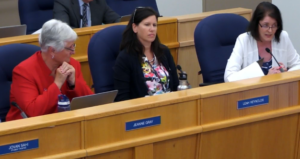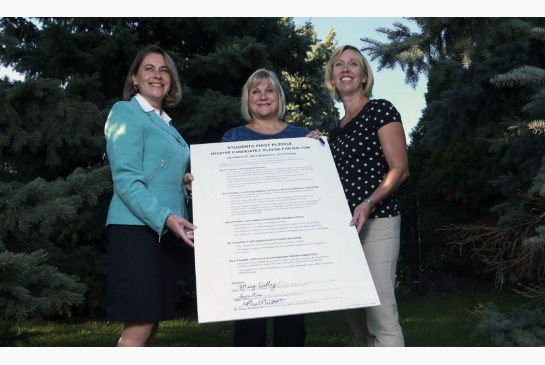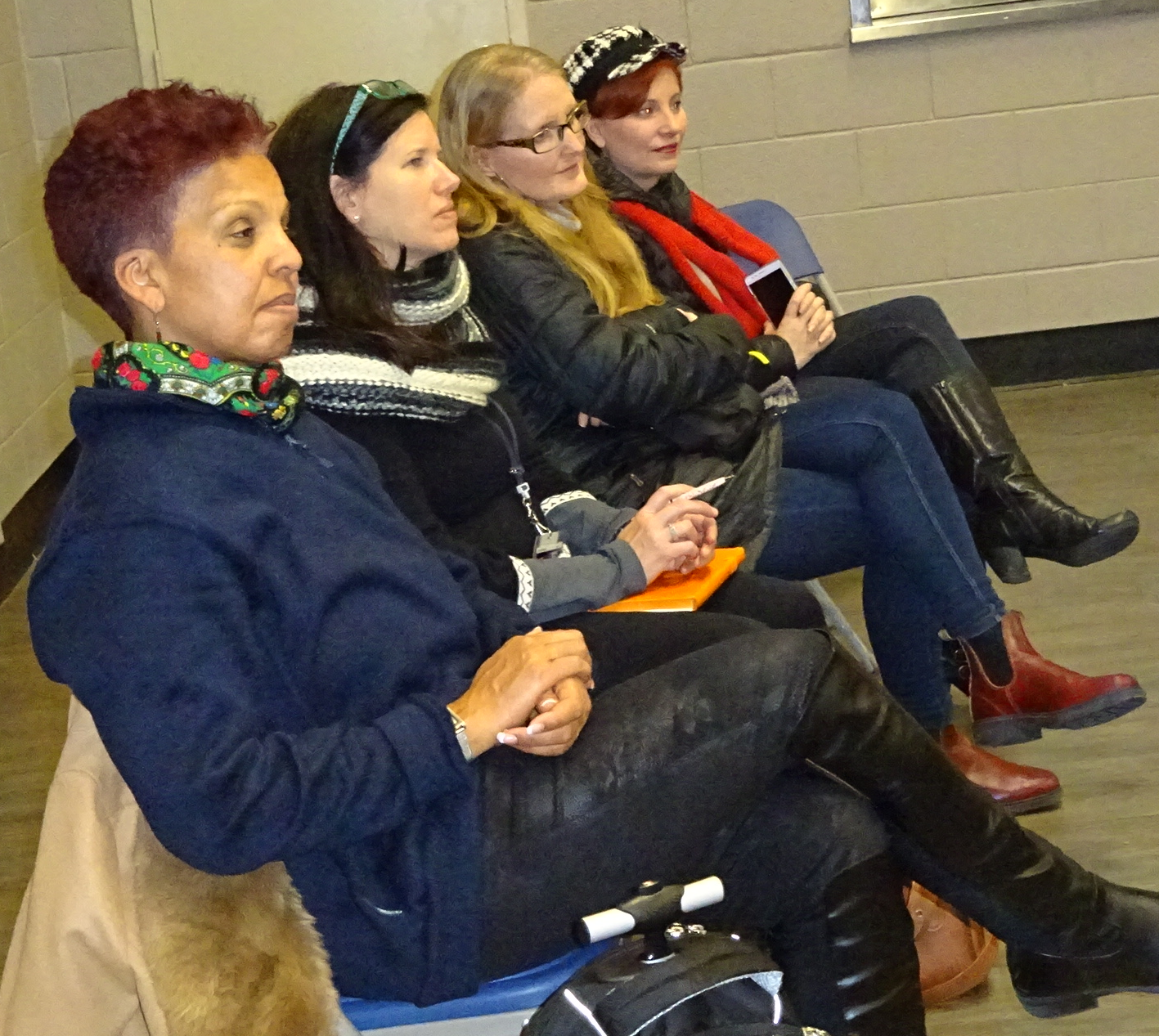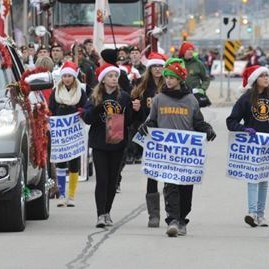 By Pepper Parr
By Pepper Parr
January 2nd, 2017
BURLINGTON, ON
The next five months are going to be filled with a lot of meetings and conversations over whether or not two high schools in Burlington should be closed.
 The Halton District School Board trustees have a major decision to make – do they accept the recommendation that came from the Director of Education to close two Burlington high schools and shift some boundaries or do they craft a motion of their own and try to sell that to the people they represent?
The Halton District School Board trustees have a major decision to make – do they accept the recommendation that came from the Director of Education to close two Burlington high schools and shift some boundaries or do they craft a motion of their own and try to sell that to the people they represent?
The Gazette has put a number of questions before each of the 11 trustees to get a sense of what their thinking is and what they see as their prime role as trustees.
The Board of Education staff have put forward a convincing argument and a set of facts that are difficult to argue with – there are now 1800 seats in high school classrooms that do not have students in them. That just isn’t a sustainable model.
A number of Gazette readers have asked how a situation like this came about and they point to a period of time before the Hayden high school was opened in the Alton Village when they feel some major errors were made by the Board’s planning department. They might be right and at some point the Gazette will do a feature on how decisions were made in the past.
The errors, if they were really made, would call for some changes in the staffing model at the Board but any mistakes made in the past can’t be corrected; the Director of Education has a significant problem which he has put in front of the elected trustees along with a proposed solution.
Closing a high school isn’t quite as drastic as closing a local hospital but when a high school closes it changes the fabric of a community and that is important – vital to some parents.
While not the prime argument, the closing of a high school impacts property values; the community wonders what the property will be used for should the buildings be demolished.
What do trustees base the decision they will make on?
Financial:
Is it financial prudence – the cost of the decision they make?
Academic:
Do the trustees first concern themselves about the academic soundness of any decision they make?
Community:
Where does community fall in their decision making?
Do they feel that schools are a vital part of a community and that every community should have a school in its neighbourhood?

Trustee candidates Oliver, Dilly and Shuttleworth signed a pledge to “act with the highest level of integrity”. One of the three was elected – she was from Oakville.
While getting themselves elected every trustee will have said something about how important schools are and that every student should be given the opportunity to have the best possible elementary and high school experience with the richest mix of course offerings possible.
The four Burlington trustees are now facing an issues they probably didn’t expect to have to deal with when they ran for office. The pressure on the Burlington trustees will be intense.
Three of the four are new to school board politics – and make no mistake about it – the closing of a school is a political issue; one that involves the full community which includes city hall.
School are one of the brighter threads in the fabric of a community. Those who expect this decision to be made by the school board trustees without any input from the wider public are both naïve and fools.

Three of Burlington’s four school board trustees listening during the first city wide public meeting at which data on what an audience thought about school closings. From the left, Richelle Papin, Leah Reynolds and on the far right Andrea Grebenc.
Of the 11 trustees only three have more than a single term in office by way of experience.
The groups that want Central high school kept open are using traditional protest tools – petitions, lawn signs and taking part in public meetings.

Central high school students in the Santa Claus parade – some thought it was a controversial stand.
The time when those tools were effective is probably past.
The one event they held did make a very strong statement – the Silent Auction raised $14,000 – to the surprise of many. The strength of local support was made clearly evident. Their participation in the Santa Claus parade was seen as controversial by some – it was an excellent way to get their point across to a larger audience.
What that group does to grow that support and turn it into something that becomes more than compelling is the challenge they face. It is a daunting challenge.
So let us see where the current crop of school board trustees stands on a couple of fundamental questions: Is their decision rationale:
Financial
Academic offerings
Community input.
Background links:
Council member’s views on the politics of a school closing




















Re: your “The Board of Education staff have put forward a convincing argument and a set of facts that are difficult to argue with – there are now 1800 seats in high school classrooms that do not have students in them. That just isn’t a sustainable model.”
I previously sent much of this comment into Councilor Meed Wards newsletter on this issue in response to another readers comment along similar issue defining lines.
I think your issue definition as 1800 excess places is thin, and not very critical, I think, for a reporter/editor. This holds besides the fact that the excess places is heading for less than 1600 by 2021.
But if we accept it at face value, what does it imply about the strictly business end of producing student spaces?
In 2012 the utilization of SRA 100 Burlington spaces was 87%, so there was a minimal excess over the Board target of 90%. It was also projected to fall and is now at about 75%. But it only fell because Hayden was opened and students were transferred there, and this continues to date, filling up portables and a projected student surplus of about 600.
What the hell is going on here may I ask, with the Board sense of planning? And this just looks to continue in this PAR.
The point being for our business model, is that there is no apparent rationale, no business case, to build Hayden, as there was no shortage of supply of student places. There was already some identifiable excess.
With such an excess supply identified, and projected to worsen, on the basis of your issue definition, what reason existed to build additional supply of students spaces at Hayden? In fact, we still don’t need Hayden on this basis.
If we made this kind of business decision, we would be in deep doo-doo, and in deeper when there are serious consequences, which there are, but not for those who made the decisions.
This decision by the Board had no justifying business case in terms of student spaces, but created an excess which is now being used to justify closing schools to make up for their mistake. Everyone knows this has just made things much worse and created a divisive mess for which no one is being held accountable.
Regarding the provision of opportunities, there was never any evidence provided to show that Hayden provided any opportunities that didn’t already exist. And there is still no evidence provided that closing other schools will provide any additional opportunities that also don’t already exist.
In fact, closing schools will require that 500 to 600 additional students are provided, rather “necessitated”, the “opportunity” to ride the bus to school instead of walk, which most of the would be displaced do at present. Some opportunity this is.
Hopefully, you can see the thinness of putting the issue as just about excess student spaces. The Board itself created the excess. It didn’t exist before Hayden. Why was Hayden built? Where’s the cost-benefit analysis of what has been created?
The only thing I have even remotely heard, is that the people in the north of Burlington, in Alton, were entitled to, or “needed” schools in their neighborhood.
Which begs the question, what about the rest of Burlington, now under the gun because of the Board building a Hayden not needed for student spaces.
And here is where the real issue mess lies, the part left out of your issue definition. Because the students were transferred in ever greater numbers, even overflowing into portables, exceeding the Hayden built supply of places, from the existing schools, and then their feeders, thus creating the excess in those schools.
So that’s where the logic of your issue definition takes us. Based on your definition, Hayden should not have been built. Is anyone going to be held accountable for this?
If Hayden neighborhood residents and parents and students “needed” their own school, whatever happened to the rest of us down here in the south? Do we not count in this?
This is the real mess that your issue definition is too thin to manage. It is much more than excess student places.